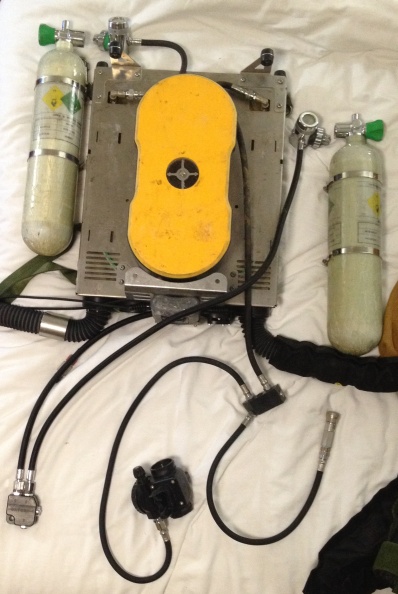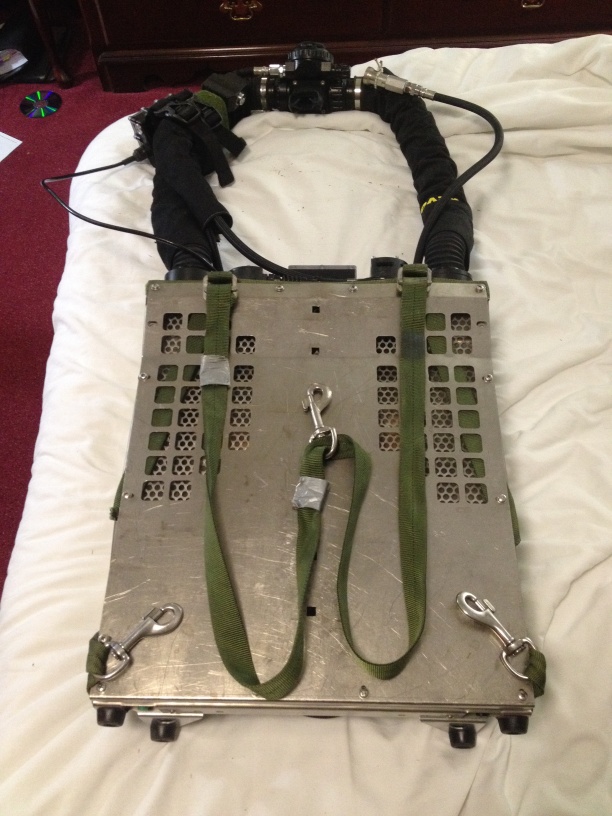Rigging a REVO for dual oxygen.
A friend of mine who is buying a rEVO asked me how I rigged mine for my 28,000 foot (round trip) dives in Tennessee using dual onboard oxygen and my standard sidemount rig as bailout, keeping the rig removable in the water for small restrictions. Thought some of you might find it interesting.
Both bottles are oxygen. The left (as viewed, not as worn) bottle is the fixed IMP 1st stage, and is plumbed as from the factory, directly to the button mechanism below it. You can manually add from this bottle using the button at the bottom of the rig, if you absolutely had to (multiple failures on the other side) but it's primary purpose is to drive the orifice. The bottle on the right (as viewed, not as worn) is a depth compensated 1st stage, and has only one line out of it, which goes to the Golem oxygen manual addition button strapped to the breathing loop. (See picture later.) The other line from the Golem button goes into the machine at the little port near the dump valve. The sole purpose of this bottle is to provide make up gas, compensating for a low orifice setpoint. Failure of this bottle means you will have to add oxygen from the bottle feeding the orifice, and will effectively halve your available oxygen time, and may not work at all down deep. The little black block with three hoses sticking out of it is the Diluent manifold. Mine sort of sucks, because it doesn't flow gas as easily as it should (poor machining, and wrong material) But it also rocks because it fits directly behind the front grate thing and because of the weird angle I machined the input face, the feed line sticks out directly in the right place, i.e. over your shoulder without a bend. The line with the QC6 is the feed line- it goes to a matching connector on either one of your sidemount bottles. One of the lines off the manifold goes to the BOV, and the other goes back to the factory connector for diluent. This allows you to manually add diluent via the bottom of the breather (never, ever had to do this) or you could manage it via the BOV (also never had to do this.) Actually, I cant think of a reason you would have to flush with DIL, that you couldn't manage with the ADV, which is of course, fed from this same factory connector.
Some things to think about: As you get deeper than the setting on your fixed IMP reg, the orifice quits pushing gas. It gets pretty obvious, the O2 levels start dropping faster than they were before. Not much faster, but I notice it. Because of this, a solenoid should be fed from the other (non-compensated) bottle. Not sure how those are plumbed, as I don't have one, but it might be difficult to move it over to the other side. This would help with some double redundancy, but making it possible to get oxygen out of both bottles in multiple ways. Any more than that, and why have bailout?
I have found that I occasionally need one additional line on the non-compensated reg. This is for creating an "oxygen short circuit" when I am pushing the rebreather and not on the loop at depth. It is a short 8" hose that is stowed on the left (as viewed) side that can be plugged into the diluent feed line- so that when I have the machine stowed for pushing (breathing hoses all curled up and stowed) it wont collapse the counterlung because it can compensate by itself by adding O2 to fill the volume. Of course that fucks the whole loop mix up, but you just dump it when you get back on the loop, and no issues. I suppose I could leave it plugged into a sidemount bottle, but I have found that I can strap it over my legs from the back hooks and scooter or swim with it in obscenely low shit. You will likely not ever need this capability.
So, failure analysis, of sorts- Anything on the fixed IMP side quits, you turn the dive, and manual add from the compensated IMP side. Anything on the compensated side quits, manual add from the fixed-IMP side via the bottom button. Pretty easy. The only issue is running out of oxygen. I'm finding that 8 hours puts me at about 1300-1500 PSI left in these little 2L CF bottles. I suppose I could get 12 hours and they would be dead empty, but then I would have to be on the big scrubbers anyway, and odds are most of that would be deco on another machine anyway, so that's hardly an issue. Even Jasper and Cow Crap were only running 5-6 hours max for 28,000 feet round trip, so at the moment, it's a non-issue. Luckily for me, they seem to use up at almost exactly the same rate. Pure luck, I'm sure.
Once concern is the diluent feed. At the moment, there is only one. If the QC6 were to shit up, I would have a problem, and they are pretty complex little devices, and frankly, I'm amazed I haven't had one die on me yet. They should have some TBO or time between mean failures, but I've never heard of someone actually having one fail in freshwater. There are some options, one being switching the BOV connector to a Q.D. type, then having one sidemount bottle with a QC6 and one with the Q.D. connector, but the Q.D. aren't DESO (double ended shut off) so you have to turn off the tank to connect/disconnect it, and then you will end up putting a little water in your system, but you could flush most of that that real easily by purging your BOV, so that is probably a minor issue. I guess that is a pretty half ass reason for not doing it, so maybe I will change that, plus, it allows for some interoperability for those tools who use the Q.D. connectors on everything.
Here is a pic of the Oxygen addition button in dive position. It stays here all the time- it's in front, not on my chest, and I don't notice it.
Here is a pic of the diluent manifold, in it's proper place. If I was cool, I would have a couple of stainless steel machine screws attaching
it to the grid, but I don't care that much, and it isn't going anywhere. Geez, my bottles are taking a beating.
And here it is in dive mode. The dil feed line actually has a small loop of bungee on the right (as viewed) hose right next to the BOV
for storage when donning/doffing the rebreather or when is being pushed around. No loose hoses, no loose pressure gauges. The only thing
I would change now is swapping the HUD and Shearwater handset for a single hardwired NERD. I Will be testing yours out when it shows up.
That replacement would remove the last loose wire (the one leading off to the handset in this picture.)
And the last pic is the connection method I use. V strap fitted under the top row of bolts, which by the way are some obscure
european crap- better change them out for some good old fashioned phillips head machine screws, or you will have to carry
your special screwdriver around to open it up, cause this thing positively fills up with rocks. The bottom connectors are similar,
just very short straps that connect to my tank attachment cups. This might not work if you have the new door handle thingies
that everyone is using these days to connect tanks, but I am not so encumbered.
Jason Richards
NSS 41539
(rchrds here)




